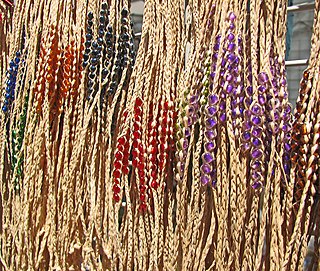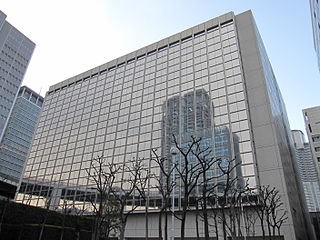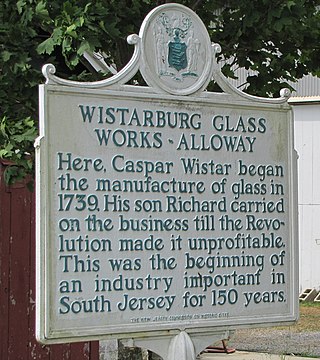
Abacá (Spanish), Musa textilis, is a species of banana native to the Philippines. The plant grows to 13–22 feet (4.0–6.7 m), and averages about 12 feet (3.7 m). The plant, also known as Manila hemp, has great economic importance, being harvested for its fiber, also called Manila hemp, extracted from the leaf-stems.

A rope is a group of yarns, plies, fibres, or strands that are twisted or braided together into a larger and stronger form. Ropes have tensile strength and so can be used for dragging and lifting. Rope is thicker and stronger than similarly constructed cord, string, and twine.

The City of Merri-bek is a local government area in metropolitan Melbourne, Australia. It comprises the inner northern suburbs between 4 and 11 kilometres from the Melbourne CBD. The Merri-bek local government area covers 51 km2 (20 sq mi), and in June 2018, it had a population of 181,725.

Brunswick is an inner-city suburb in Melbourne, Victoria, Australia, 5 km (3.1 mi) north of Melbourne's Central Business District, located within the City of Merri-bek local government area. Brunswick recorded a population of 24,896 at the 2021 census.

Noel Counihan was an Australian social realist painter, printmaker, cartoonist and illustrator active in the 1940s and 1950s in Melbourne. An atheist, communist, and art activist, Counihan made art in response to the politics and social hardships of his times. He is regarded as one of Australia's major artists of the 20th century.
The Brunswick Progress Association is a community organisation active in the City of Merri-bek Council area, and in particular the suburbs of Brunswick and Coburg, inner northern suburbs of Melbourne, Victoria, Australia. It was first established in 1905 and celebrated its centenary of community activism in 2005.

Brunswick East is an inner-city suburb in Melbourne, Victoria, Australia, 5 km (3.1 mi) north of Melbourne's Central Business District, located within the City of Merri-bek local government area. Brunswick East recorded a population of 13,279 at the 2021 census.

CERES Community Environment Park is a 4.5-hectare (11-acre) not-for-profit environmental education centre and social enterprise hub located in urban Brunswick East, Victoria, Australia.

The Division of Wills is an Australian electoral division of Victoria. It is currently represented by Peter Khalil of the Australian Labor Party.
Courtaulds was a United Kingdom-based manufacturer of fabric, clothing, artificial fibres, and chemicals. It was established in 1794 and became the world's leading man-made fibre production company before being broken up in 1990 into Courtaulds plc and Courtaulds Textiles Ltd.

Peoria Cordage Company was a major manufacturer of twine and cords, It operated in Peoria, Illinois for almost a century.

The City of Brunswick was a local government area in the inner-northern suburbs of Melbourne, Victoria, Australia. It comprised the suburbs of Brunswick, Brunswick East and West Brunswick. It ceased to exist on 22 June 1994, when its council was disbanded by the Kennett Government and replaced with appointed commissioners, who oversaw its amalgamation with the City of Coburg and parts of the City of Broadmeadows, to create the City of Moreland.
The National Cordage Company was formed in New Jersey in 1887, for the importation of hemp and the manufacture and sale of cordage. It is noteworthy because of its expansion at the beginning of the 1890s and its initial public offering of $5,000,000 of 8% cumulative preferred stock. The corporation sought to decrease the cost of production and distribution of their products. It issued a prospectus on August 1, 1887 and quickly sought to dominate the market in raw materials.

Hemp jewelry uses hemp twine material which is made from the Cannabis sativa plant, otherwise known as “Common Hemp”, which is cultivated to make goods such as food, fuel, clothing and textiles, cosmetics, paints, paper, building materials, and plastics, among others. Some types of hemp jewelry include bracelets, necklaces, anklets, rings, watches, masks, purses, and other adornments. The jewelry can also make use of other materials, such as glass, wood, bones, rocks, or gems.

A braiding machine is a device that interlaces three or more strands of yarn or wire to create a variety of materials, including rope, reinforced hose, covered power cords, and some types of lace. Braiding materials include natural and synthetic yarns, metal wires, leather tapes, and others.

Toyobo Co., Ltd. is one of Japan's top makers of fibers and textiles, including synthetic fibers and natural fibers, such as cotton and wool.

Doon is a suburban community and former village which is now a part of the city of Kitchener, Ontario, Canada. Doon was settled around 1800 by German Mennonites from Pennsylvania, and after 1830 by Scottish immigrants. The area is located at the confluence of Schneider Creek and the Grand River. The post office was opened in 1845. A large flour mill, oatmeal mill, distillery and sawmill were built on the Doon River over the following years. The Perine brothers established extensive linen works and flax mills near the settlement. By 1870, there was a single church, Presbyterian, a variety of tradesmen and a population of 200.

The Wistarburg Glass Works was the first successful glass factory and joint-venture enterprise in the Thirteen Colonies. Caspar Wistar founded the glass works company in 1739. He began by recruiting experienced glass artisans from Europe, and built homes for the workers along with a mansion for the factory's foreman. Wistar also had a company store built near the factory.
Anthony Cianflone is an Australian politician who is a current member of the Victorian Legislative Assembly, representing the state electoral district of Pascoe Vale, which contains the suburbs of Pascoe Vale, Coburg and parts of Brunswick West. He was elected to his seat in the 2022 state election.
















